Indian Head Gold Dollars

 Indian Princess Gold Dollars - minted in 2 types with big and small head design
Indian Princess Gold Dollars - minted in 2 types with big and small head design
The Indian Head Gold Dollars replaced the Liberty Head Gold Dollars in 1854. The new coins depict Lady Liberty as an Indian princess. The US Mint produced the Indian Princess Gold Dollars from 1854 to 1889 at the US Mint facilities in Philadelphia, New Orleans, San Francisco, Charlotte and Dahlonega. Despite that relatively long mintage period, only about 7 million coins were struck in total. The $1 Indian Gold Dollars are therefore quite rare gold coins that will cost you a higher premium if you're lucky to find them listed for sale online. The mintage numbers of proof coins were however higher than usual for pre-1933 U.S. gold coins, yet proofs should still be difficult to obtain.
The Indian Head Dollars were made of 90% gold and 10% copper with each coin containing 0.04837 oz of gold. The obverse side of the coins shows Lady Liberty wearing a Native American headdress. The reverse depicts a different wreath design than the earlier produced Liberty Gold Dollars. An agricultural wreath of corn, cotton, wheat and tobacco tied with a bow is shown. The same depiction of Lady Liberty as an Indian princess and of the wreath on the reverse can be seen on the 3 Dollar Indian Gold coin.
When you buy gold in the form of these coins, you should know that two coin types exist. They distinguish themselves by the size of the Indian Princess portrait on the obverse side. American buyers that are investing in gold for their retirement should take note that the coins are not eligible for inclusion in Individual Retirement Accounts (IRA's) since they are classified as collectible gold coins by the IRS.
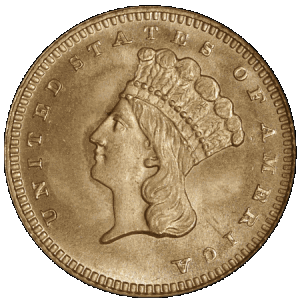
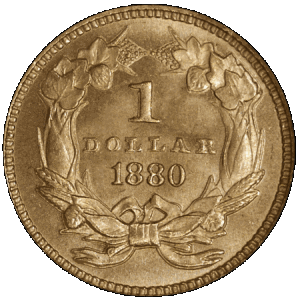
Coin Fact Sheet
| Weight | Face Value | Purity | Diameter |
|---|---|---|---|
| 0.04837 oz | US $ 1 | 90% | 15 mm |
Total Mintage: 6,962,119
Indian Gold Dollar Coin Design
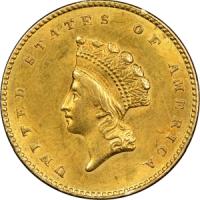
Chief Engraver James B. Longacre of the Philadelphia Mint designed both types of the Indian Gold Dollar. The coin's obverse side depicts Lady Liberty wearing a Native American headdress that has the word "LIBERTY" inscribed on it. Around the coin's periphery appears the inscription "UNITED STATES OF AMERICA".
There are two subtypes of the Indian Gold Dollar coin regarding the size of the portrait on the obverse. The coins were at first minted with a smaller head design from 1854 to 1856. These coins on which the Indian Princess is depicted with a small head are now generally referred to as the Type 2 Gold Dollar. (The Liberty Head Gold Dollars are the Type 1). The coins with the large head design that were minted from 1856 to 1889 are now generally referred to as the Type 3. The flipping image near the top of the page shows a Type 3 coin with the large head design from 1880. On the left you see an image of the obverse of a Type 2 coin with the smaller head design from 1855.
The design on the reverse side depicts an agricultural wreath of corn, cotton, wheat and tobacco tied with a bow. This selection of produce was made to include the popular agricultural crops of both the Northern and Southern United States. The coin's denomination "1 DOLLAR" and the year of mintage appears inside the wreath. Gold Dollars that were minted in New Orleans (mint mark: O), San Francisco (mint mark: S), Charlotte (mint mark: C) or Dahlonega (mint mark: D) contain a mint mark just below the bow at the bottom. However, coins that were minted at the main Philadelphia branch of the United States Mint don't have any mint mark.
History of the Indian Gold Dollar
The Indian Head Gold Dollar replaced the Liberty Gold Dollar in 1854. Compared with its predecessor, the Indian Head Dollar is slightly thinner but has a larger diameter (enlarged from 13 mm to 15 mm). Chief Engraver James B. Longacre of the Philadelphia Mint created a new design for both sides of the altered coin that is now commonly referred to as the "Indian Princess". In 1856, the design of the obverse side was changed again by enlarging the size of the Indian Princess image and lowering its relief. The previous high relief portrait had created problems with the striking of the date on the reverse side which led to the change. The mint in San Francisco only switched to the new design in 1857 though.
Even though production of the Indian Princess Gold Dollar lasted from 1854 to 1889, only the US Mint facility in Philadelphia produced them every year during this period.
Rare Dates
The Indian Princess Gold Dollars that were minted in San Francisco in 1856 (24,600 coins still with the smaller head design) and 1857 (10,000 coins) as well as in New Orleans in 1855 (55,000 coins with the smaller head design) are now rarities. The same is true for the coins minted in Charlotte in 1855 (9,803 coins with the smaller head design), 1857 (13,280 coins) and 1859 (5,235 coins). The coins minted in Dahlonega are rare as well for their entire length of production in the years 1855 (1,811 coins with the smaller head design), 1856 (1,460 coins), 1857 (3,533 coins), 1858 (3,477 coins), 1859 (4,952 coins), 1860 (1,566 coins) and 1861 (1,250 coins).
Mintage Numbers
Annual mintage of the $1 Indian Princess gold coin at the various US Mint branches varied between 400 coins (Philadelphia 1875) and 1,762,936 coins (Philadelphia 1856). Regarding the two existing types of the coin, a total of 1,633,426 Type 2 coins with the "small head" design were minted between 1854 and 1856 whereas 5,328,693 Type 3 coins with the larger head were minted between 1856 and 1889.
Proof coins were exclusively minted at the Philadelphia branch of the US Mint and confirmed proof mintage varied between 20 coins and 1,779 coins (1889). Definite proof mintage numbers for the years 1854 to 1858 are not totally certain. Proof mintage of the Indian Dollar gold coin was far higher in the years 1884 - 1889 than is typical with pre-1933 U.S. gold coins.
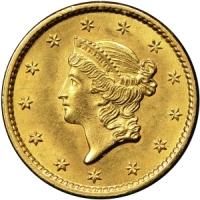
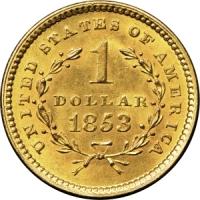
Liberty Gold Dollars
The $1 Liberty Gold Dollars were the predecessors of the $1 Indian Head Gold Dollars. The US Mint produced them from 1849 to 1854. The coins were struck at the US Mint facilities in Philadelphia, New Orleans, San Francisco, Charlotte and Dahlonega. Their composition is 90% gold and 10% copper with each coin containing 0.04837 oz of gold. About 12.6 million Liberty Head Gold Dollars were minted. A total of only 7 proof coins are believed to have been minted in 1849. No additional proof coins were minted in the following years. A profile of Lady Liberty appears on the obverse and a laurel wreath that is tied with a bow can be seen on the reverse.
The Liberty Gold Dollar page gives more information about the coins and allows you to compare current prices.